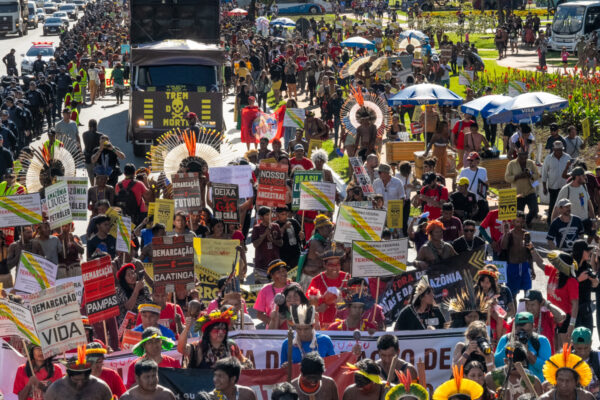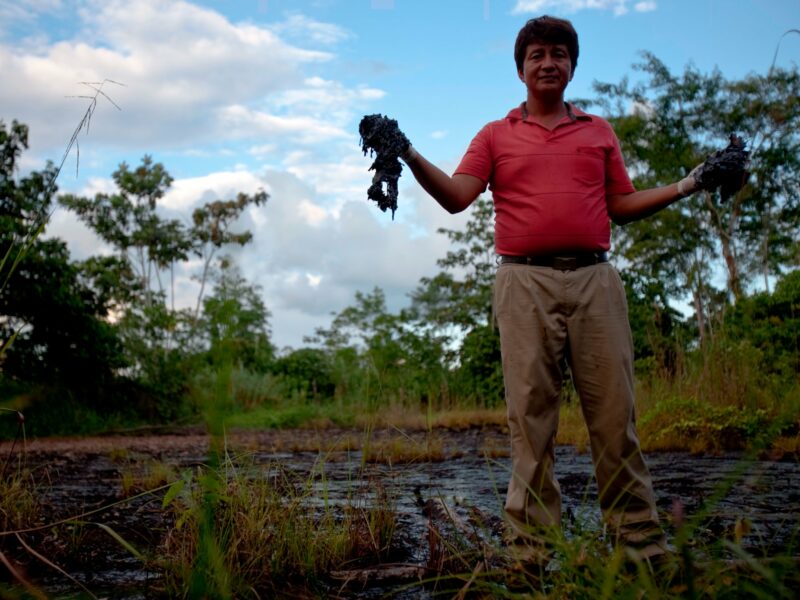Rabbi Dan Goldblatt returned from Ecuador recently, and what he saw there
nearly broke his heart.
The spiritual leader of the independent Beth Chaim Congregation in Danville
and a longtime environmental activist, Goldblatt did not go as a tourist. He
went as part of a delegation of interfaith clergy from the area to bear
witness to the destruction of the Amazon rainforest by ChevronTexaco. The
multinational oil company’s worldwide headquarters are in San Ramon,
adjacent to Danville.
“We as Jews have a responsibility to be stewards of the earth,” said
Goldblatt, who was a founding member of Bay Area COEJL (Coalition on the
Environment and Jewish Life) and was involved in trying to save Humboldt
County’s Headwaters Forest in the mid-’90s. “Throughout so much of our
prayer, we’re celebrating creation, and it just seems obvious that this is a
priority of our spiritual tradition.”
In 1964, Texaco Petroleum Co., a subsidiary of Texaco, began 30 years of
drilling in some of the most pristine areas of rainforest in Ecuador, with
the government’s permission.
Texaco merged with Chevron a few years ago. In May, a delegation
representing four indigenous tribes came from Ecuador to San Ramon for three
weeks. Although they met with community leaders, clergy and elected
officials, their main goal was to meet with the CEO of ChevronTexaco, David
O’Reilly. Their request for a meeting went unheeded.
Goldblatt’s delegation also contacted O’Reilly, both before it left and
after it returned. While he did not meet with them, Stephen Burns, manager
for social and corporate responsibility, did. Goldblatt described it as a
“cordial” meeting, and expressed hope that it was the beginning of an
ongoing dialogue.
The visitors from Ecuador were part of a class-action lawsuit filed on
behalf of four tribes of 30,000 Ecuadorians against ChevronTexaco. A court
in the United States determined that the case should be decided in Ecuador.
For six days in October, the plaintiffs testified to a judge in the small
town of Lago Agrio, 115 miles northeast of the capital city of Quito. Now
the judge will tour the region for 50 days to see for himself, and then the
discovery process will begin, which could take up to a year.
Under the advice of counsel, ChevronTexaco has not spoken publicly on the
issue and did not return a call from j., but in its most recent corporate
responsibility report, the company argues that in giving $40 million to
repair soil and water damage, it has fulfilled its responsibilities.
However, after seeing that damage firsthand, Goldblatt says that
ChevronTexaco’s responsibilities are far from fulfilled.
Goldblatt joined three other local clergy and one labor organizer on a trip
sponsored by Amazon Watch, a Los Angeles-based organization.
First, they toured the Cuyabeno Wilderness Preserve, “what is reputed to be
one of the most pristine nature reserves in all of the Amazon,” said
Goldblatt. “For time immemorial, it has been this incredibly lush and
beautiful amazing gem of biodiversity, a rich storehouse of plants and trees
and wildlife that’s practically unmatched.”
But downriver from this area, they were in for a shock. In a village of 175
members of the Cofan tribe, “these people were living in the middle of the
rainforest where there is water everywhere, streams and rivers, and the rain
is constant, but there is no potable water to drink.”
The villagers can’t even collect the rain, because the toxins in the area
have turned it into acid rain. Children bathe in streams with huge oil
slicks. And while village members had managed to locate a spring, by digging
deeply into the earth, they have to line up early in the morning to collect
water from it. Often, there isn’t enough to go around.
Goldblatt reported seeing “huge open sludge pits, filled with the viscous
oil spill-off from the wells themselves.” The crude oil then runs into the
streams when it rains, further contaminating them.
And as if this devastation to the environment weren’t bad enough, Goldblatt
said, the human devastation is equally, if not more, horrifying. At a high
school they visited, the group learned 80 percent of the students report
that they had at least one family member who is sick. The illnesses range
from cancers of the intestine, lungs and uterus — causing women’s monthly
menses to last 15 days — to respiratory illnesses, none of which they had 20
years ago. Many children have been born without brains.
A nurse who worked in a clinic near one of the affected areas spoke of how
difficult it was for them to deal with the malaria and other diseases common
to the area, let alone these foreign ailments, for which they are totally
unprepared.
One young girl “read a letter she had written asking us to go back to our
faith communities and pray for them,” he said.
Goldblatt said that it is possible to re-inject highly toxic water back into
the earth so the runoff doesn’t affect the streams and rivers, but it is
much more expensive than the $40 million ChevronTexaco already gave to clean
up the area.
“It would take billions [of dollars] to do it properly, but there’s no
monitoring. It’s like with the Native Americans here; they have no power,
and no access to wealth, so who cares?”
Goldblatt said the American visitors were not only able to tell their
stories here, but they brought awareness to the problem in Ecuador as well.
Because they were the first Americans to show solidarity with those being
affected, they were widely covered in the Ecuadorian press.
In Quito, they met with union and religious leaders. “They said ‘We’re
deeply ashamed that you had to come here to remind us of our responsibility
to the people in our own country,’” he said.
They were able to meet with the judge who is presiding over the case, who
told them he would not be bought, and justice would be served.
While they were visiting, one of the most visible environmental activists
among the indigenous people was assassinated in broad daylight.
At his memorial service, they were asked to speak. “It was clear to them
that this [attack] was a threat,” he said.
The clergy have since met with the Contra Costa Board of Supervisors to
discuss making the affected area in Ecuador a sister region, and a
congressional delegation from the Bay Area may go next, said Goldblatt.
While the lawsuit could take years to settle, Goldblatt hopes that his
sharing what he saw will have an impact. He just did so at a national
gathering of Renewal rabbis.
“It’s horrible to see people who have lived for thousands of years in
complete harmony with their environment, and now it’s being totally
destroyed and their culture along with it,” he said.
Among the things that struck him most, he said, was that unlike so many
political conflicts that seem unsolvable, this one has a clear-cut answer.
“This one is about resources, and responding to people who are sick and
dying. Certainly there’s been damage to the environment that’s irreversible,
but something can be done to help. This is on the scope of Chernobyl, but no
one knows about it because it didn’t happen in Europe or in a First World
country,” Goldblatt said.
“It’s bigger than lawsuits. It’s about human beings suffering and dying.
They have a responsibility to help. They need to do what’s right, and we’re
hopeful that they will.”
The following story from J, the Jewish news weekly of Northern California, formerly the Jewish Bulletin of Northern California (http://www.jewishsf.com/)













